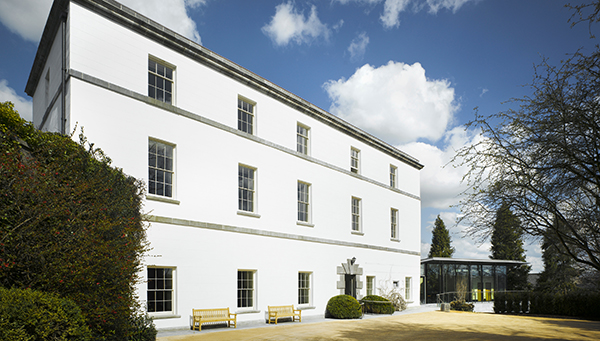Áras na hOidhreachta
Published in Gems of Architecture, Issue 3 (May/June 2021), Volume 29Church Lane, Kilkenny
By Colm Murray
The premises now occupied by the Heritage Council stand on a historic site. The former bishop’s palace in Kilkenny forms part of the St Canice’s Cathedral precinct and, together with the cathedral and round tower, the library and deanery, occupies an elevated position overlooking the medieval city. Work on a palace for the bishop of Ossory began c. 1350 when Bishop de Ledrede (d. 1361) ‘obtained the King’s leave for demolishing three Churches without the Walls, and employed the Stones in building an Episcopal Palace near the Cathedral’. The exact form of the original palace is still the subject of debate, but it is generally accepted to have taken the form of a rectangular ‘long house’. Entry was by way of the upper floor, where the main rooms were supported on stone vaults, with stores below.
Further works were carried out by Bishop Baron (d. 1550), including the construction of a tower-house at the eastern end of the palace. It is a little mind-boggling to think of a tower-house as an extension to an existing building but that is indeed the case in Kilkenny!
Kilkenny’s cathedral precinct suffered badly during the eleven years of warfare that convulsed Ireland in the mid-seventeenth century, and Bishop Williams (d. 1672) recorded in 1661 how he found the palace ‘all ruined, and nothing standing but the bare walls, without roofs’. Large sums of money were spent on rehabilitating the palace and a contract from 1672 shows that £130 14s. went on repairs and new windows alone. Bishop Parry (d. 1677) expended at least another £270 on improvements and a kitchen wing was added at this time.
Bishop Este greatly enhanced the palace in the 1730s, making the medieval hulk conform to the image of a Georgian country house, the entrance signalled by a robust ‘Rustic Palladian’ doorcase copied from an illustration in Practical architecture (1724) by William Halfpenny. Four rooms and a staircase, an elaborate confection of fluted balusters and Corinthian colonettes, were added at a cost of £1,956. Walter Harris commented that Este ‘hath made [the palace] commodious, regular, and noble’.
The two grandest rooms in the palace today are the ground-floor dining parlour and the withdrawing room immediately above it. The detailing of the joinery and plasterwork is in the elegant Regency style and suggests that both rooms were created during the episcopacy of Bishop Kearney (d. 1813).
The Georgian character was identified as the key theme for architectural re-presentation when the Heritage Council began restoring the palace as its new headquarters in 2006. Conscious of the rich tapestry of history at stake, the adaptation and restoration were guided by the ethos that heritage is a living thing and that having a respectful attitude to it does not prohibit sensitively planned contemporary interventions. In line with this, it was decided that a new pavilion of glass and steel would be supported by the foundations of the seventeenth-century kitchen wing, an apt metaphor for the work of the Heritage Council. This heritage-led regeneration has ensured that the former bishop’s palace has been saved for the benefit and enjoyment of generations to come.
Colm Murray is the Heritage Council’s Architecture Officer. Series based on the NIAH’s ‘building of the month’, www.buildingsofireland.com.

Above: Áras na hOidhreachta, headquarters of the Heritage Council. The former bishop’s palace forms part of Kilkenny’s St Canice’s Cathedral precinct. (Heritage Council)
















